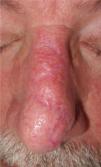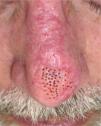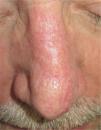Trapdoor effect is a raised deformity that can occur within the confines of a semicircular or circular scar. It typically occurs after placement of a transposition flap on the cheeks and nose and can take between 3 weeks and 8 months to appear.1 It is thought to be secondary to lymphatic and venous obstruction, excess adipose tissue, or hypertrophy or contraction of the scar and has also been associated with beveled surgical wound edges.2,3 Various techniques are used to improve the defect, although no consensus has been reached on treatment.
We report the case of a patient with trapdoor deformity after removal of an infiltrating basal cell carcinoma on the tip of the nose 1 year previously. The deformity was reconstructed using a bilobed transposition flap from the nasal pyramid (Fig. 1). The correction process involved 5 sessions with carbon dioxide laser (SE-20-30w Franckline, Intermedic) after anesthesia with a mepivacaine 2% infiltration. The sessions were every 8 weeks with the device in surgical mode at 5 W/cm2. The procedure was based on our experience and enabled recovery of the skin and stimulation of fibroblasts. At each session, treatment was administered focally to several points (as in a fractional approach) distributed throughout the flap and on the edges of the scar, but not in the depressed area (Fig. 2). We chose a focal approach to ensure that the laser reached as deeply as possible so that the retraction induced would flatten the flap. After carbon dioxide laser treatment, the appearance of the flap improved considerably, with reduced thickness and erythema (Fig. 3). The patient had not previously received treatment to improve the defect. No abnormalities of texture or changes in pigmentation were observed after treatment. Similarly, no recurrence of the defect was recorded after more than 2 years’ follow-up.
The treatment of choice for this problem has not yet been defined, although there are several alternatives to prevent and correct it.
In order to prevent the deformity, it is first necessary to fulfil the basic surgical principles that favor proper scarring: appropriate eversion of the edges of the surgical wound, avoidance of permanent suture marks, alignment of the scar with natural tension lines, and sparing of anatomical units.4 Specifically, the trapdoor effect can be minimized by making a peripheral depression on the area that receives the flap in order to reduce tension or by reducing the curvature of the incisions, thus creating right angles where there would normally be a curved edge, since flaps with straight edges prevent circular contracture of the scar.5
Correction can be based on various procedures, including manual lymphatic drainage, intralesional corticosteroids, surgery, super shaving, and laser therapy.
Manual lymphatic drainage can lead to slight cosmetic improvements in the flap, although it is a laborious technique that must be performed daily for 1 month.6 Intralesional injection of corticosteroids, mainly with triamcinolone acetonide, seems to be successful in milder deformities. The more severe cases require surgery to improve fibrosis by lifting the flap or performing Z-plasty, either alone or in combination with other procedures.7
Super shaving and ablative and nonablative laser therapy are more recently described options.
Super shaving involves tangential excision of the most bulging part of the defect, by removing the epidermis and dermis and then abrading the surface to level off the surrounding tissue. This procedure is followed by local treatment with topical antibiotics. Good results have been reported for this technique, albeit in a low number of patients.8
Lastly, ablative and nonablative laser therapy have been used in recent years to improve both atrophic and hypertrophic scars.
Nonablative laser systems can improve the trapdoor effect. However, even after many sessions, it is difficult to completely flatten the deformity, since it is highly unlikely that a significant amount of energy can be delivered to fatty tissue with these systems.
Ablative systems, on the other hand, enable a more rapid response. The only study performed in this sense used fractional carbon dioxide laser.9
The rationale for treatment with a surgical laser simulating a fractional approach is based on 2 suppositions. First, leaving areas of healthy skin favors scarring and minimizes the possibility of adverse effects. Second, thickness is reduced by reaching the fatty tissue; therefore, traction of the underlying dermis and epidermis is induced, thus leveling off the defect. The maximum pulse for fractional systems does not exceed 2 or 3 ms. Performing the technique in surgical mode enables us to significantly increase this time and achieve the desired results in a more efficacious manner.
As discussed, we believe that carbon dioxide laser is appropriate for the treatment of trapdoor deformity because it is effective, simple, and rapid, with little postoperative morbidity. It also enables patients to return to their normal activities, and the cosmetic outcome is excellent.
FundingThe authors declare that no funding was received for the present study.
Conflicts of InterestThe authors declare that they have no conflicts of interest.
Please cite this article as: Martínez Campayo N, Bugallo Sanz JI, del Pozo Losada J, Paradela de la Morena S. Corrección del efecto trampilla de un colgajo nasal con láser CO2. Actas Dermosifiliogr. 2022;113:104–106.










